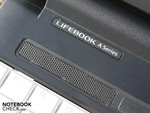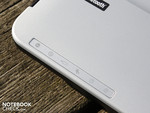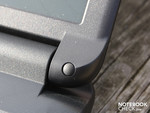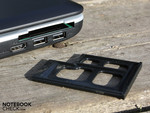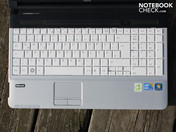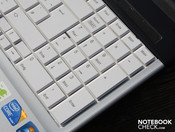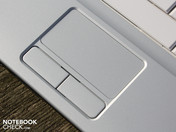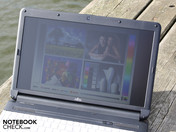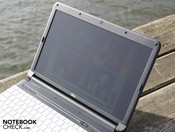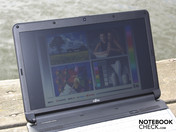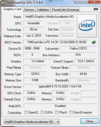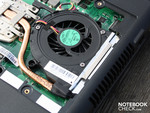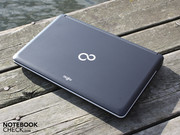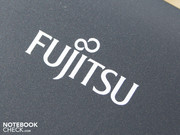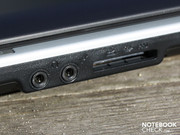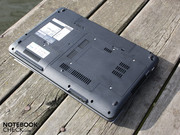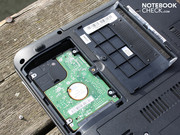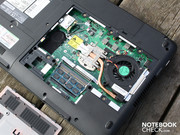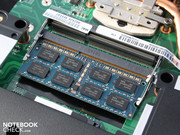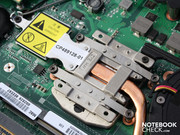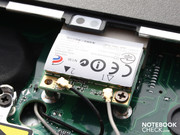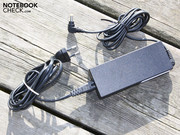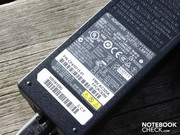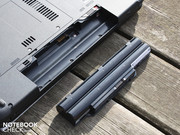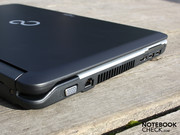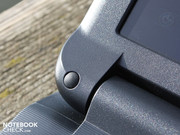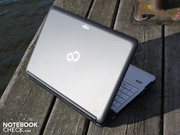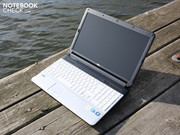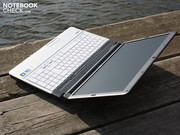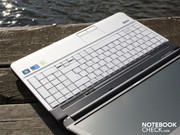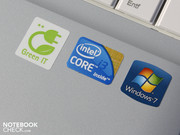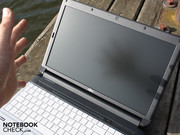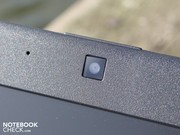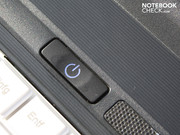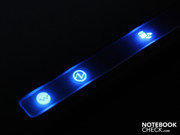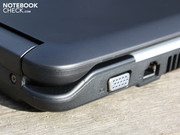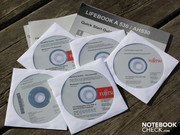Review Fujitsu LifeBook A530 Notebook

Are you looking for a cheap office laptop? Well then, good look with the search; you're almost snowed under with offers. Even from 350 Euro fully-equipped 15.6-inch devices are to be had. In the price range up to 500 Euro, there are AMD's Athlon/Turion processors or Intel's Pentium dual-core or respectively Celeron. Also Core 2 Duo processors from the generation up to 2009 can be found here (e.g. Lenovo G530 or HP Compaq 615).
Of course, you don't want yesterday's technology, right (Core 2 Duo, Penryn)? How about the 2010 Intel Generation? If you can open your wallet a bit further and spend around 550 Euro, the Core i3 laptops are sure to catch your eye. A cheap system of this kind is the Lenovo G560, which is available with the Core i3-350M from 440 Euro (without Windows operating system).
If you're put off by the glossy display of the Lenovo G560, you might rummage a little further and you'll almost inevitably come across our test device Fujitsu Lifebook A530 in the Core i3-350M variant (A5300MF101DE). With Windows 7 Professional and a matte display the 15.6-incher seems to be a lucrative offer for future-oriented office users. Find out in our extensive test report if we can confirm this.
Case
Visually, the Fujitsu Lifebook A530 is fitted with plastic. There are, apart from the hand rest area, no lacquered surfaces. However, we don't just want to talk about absolute austerity, as the silver working environment and the white keys clearly relax the visuals and give the 15.6-incher a pleasant look. The details are, on the whole, somewhat more imaginative than those of the Core i3 competitor, Lenovo's G560. The loudspeakers have a perforated grid, the power key illuminates blue and the Lifebook lettering above the keyboard is silver.
The surface on the display lid and the working environment are made from a non-slip matte plastic. Fingerprints no more than subtly remain on the slightly rubberised lid. The base plate is made from a rough plastic.
The case is characterised by very good pressure stability. The working area, keyboard and base plate can't be dented anywhere. Even the base plate above the optical drive is pressure-resistant. With two hands, the base unit can only be distorted with a lot of force.
The lid is held firmly in position by the taut hinges. No see-sawing is present. The joints give a stable and durable impression and they sit in position extremely sturdily. The maximum opening angle of around 145 degrees is more than enough for use on the lap.
Connectivity
The connections are concentrated on the left side of the case, where the air outlet is also to be found. Here users will find the obligatory Ethernet-RJ45 port for the network cable, the VGA port for the external TFT and two USB 2.0 ports for peripherals. Also the price-conscious user doesn't have to do without HDMI, which is a great advantage over the cheap competitor, the Lenovo G560. An external TFT or also a TV can be connected via HDMI.
A highlight is the ExpressCard54 slot for upgrade cards on the left side. With this extra interfaces can be added, e.g. USB 3.0 or FireWire. The appropriate cards are commercially available for this, and ExpressCard34 cards also fit in the slot.
The headphone output and the microphone input grace front of the case. The clear inscription points out the supported formats (SD/MS/MS Pro/MMC). On the rear there are no connections apart from the Kensington Lock. For substantial use on the desk it's a shame that all cables are gathered on the visible sides. Even the cumbersome HDMI cable or the arranged USB ports could limit the area of an external mouse.
The tools on our test device include a fast Atheros AR9285 wireless card (IEEE 802.11b/g/n). Also Bluetooth is on board of the low-cost office laptop. If you prefer to plug in a cable, the full bandwidth of the Realtek PCIe GBE Family Controller is available. The LAN adapter therefore supports Gigabit Ethernet.
Input Devices
Keyboard
The keyboard of the 15.6-inch device belongs to the office-suitable category. When typing the keys have a clear pressure point and a sufficient stroke length, yet the stroke is soft. The typing feeling could be too spongy for some users. A small problem (as a matter of practice) is the planar surface of the keys. Our fingers don't instinctively find the middle of the key and instead they are caught slipping on the hard edges of the next key.
The keys in an aluminium hull (splash-proof protection) are firm and only minimally give way above the optical drive. For a demanding user, the gray and rather less visible inscription of the keys is worthy of criticism.
The layout of the large Enter-, Shift- and Backspace-keys is generous. Fujitsu has only squeezed the arrow keys under the Shift key and halved their size. Even so they are offset a free space. A number pad in the standard layout is present and facilitates input of numbers and use of a calculator.
Touchpad
Why Fujitsu deploys a touchpad in minute netbook dimensions remains a mystery to us. It's set it in clear recess and seems like a child's toy (short stroke) with its rickety, loud keys. The surface is sensitive into the outer regions. Both mouse keys are sunk, which has a negative effect on smooth use. Thumbs stumble against the lower border (part of the hand rest).
The multi-touch pad (Synaptics V7.2) can be used with two fingers. Zooming or scrolling with two fingers is deactivated by default, just like horizontal and vertical scrolling (lower and right scrollbar, one finger). Customers should therefore directly navigate with the mouse and use the best settings for themselves.
Display
Fujitsu deploys a WXGA panel with a native resolution of 1366 x 768 pixels. The 16:9 display (LP156WH2-TLBA) is clearly anti-glare, meaning there are as good as no reflections at all. The contrast extremely low at just 144:1 but this is unsurprising for an office laptop. An estimated 90 percent of our test devices don't exceed 200:1. The measured black value is 1.4 cd/m². The widescreen display therefore doesn't show dark areas in a deep black. A grey shimmer remains present.
| |||||||||||||||||||||||||
Brightness Distribution: 95 %
Center on Battery: 201 cd/m²
Contrast: 144:1 (Black: 1.4 cd/m²)
The display distributes brightness very consistently across the panel (95%), meaning there are very few abnormalities of the LED background illumination. Minimum and maximum are only 11 cd/m² apart. On the whole the brightness is thoroughly suitable with an average of 199 cd/m².
The display of the Fujitsu Lifebook A530 is suited for outdoor use. No matter how we expose the 15.6-inch device to the sun, there are no distracting reflections. Admittedly the insufficient brightness causes problems in the sun. The panel is then simply too dark to be able to pleasantly work. A shady area will often solve the problem.
When it comes to viewing angles, the A530 turns out to be limited. Viewing angles describe whether colours or writing can still be clearly recognised from a lateral view. We don't have much leeway on the 15.6-inch panel. If the eyes deviate up or down (vertical) the colours clearly fade even at the smallest deviation (around 10 degrees). To the right or left (horizontal) we can deviate up to 45 degrees from the middle. Only then do colours invert and the TFT becomes much darker.
Performance
Intel's 2010 mobile processors under the names Core i3, i5 and i7 aren't popular without reason and are rather high on the wish list. The CPUs can scale their performance thanks to Turbo-Boost technology (low energy consumption when idle) and they offer applications two additional virtual threads through hyper-threading. Admittedly, Turbo-Boost isn't found in the deployed Core i3-350M, as it's reserved to i5 and i7 CPUs.
The Core i3-350M (2 x 2.26 GHz) is the faster-clocked sibling of the i3-330M (2.13 GHz) used by many manufacturers. We are going to find out if that means a relevant performance advantage for customers.
The dual-core CPU has 3 MB L2 cache (Intel Smart Cache) and an integrated graphics unit. The Intel HD on the processor package takes care of video display alone and does it comparatively efficiently. There's no dedicated GPU on this system.
Two gigabytes of DDR3 SDRAM are available to the i3-350M. This amount sits on a single module and can be slightly increased by the free RAM slot. For Windows 7 systems (here Professional 64 Bit) 4 gigabytes are almost standard.
The Core i3-350M (2.26 GHz) reaches 1.88 points in Cinebench R11.5 (64 Bit). Therefore the CPU is slower than the mid-range i5-520M and i5-430M. 520M laptops (2.4 GHz) reach around 2.2. points, whilst 430M CPUs (2.26 GHz) achieve 2.0 points. The 330M (2.13 GHz) gets 1.8 points in the CPU test, which is down to the small difference in clock speed.
In single-core computing the 2.26 GHz of the i3-350M is defeated by the i5-430M with the same clock speed due to the lack of Turbo Boost. The latter reaches up to 3.362 points (Cinebench R10 Single Core 64 Bit, Sony Vaio VPC-EB1S1E/BJ). The 350M in the A530 reaches 3.138 points. 330M laptops are slightly beaten with around 2.900 points.
The Core i3-350M is entry-level in terms of performance, even if not the worst. Users are thus armed for the multi-tasking applications of the coming years. Performance-oriented users that elaborately edit photos or often encode audio/video are better served with a Turbo-Boost-capable i5 processor.
The IGP graphics Intel Graphics Media Accelerator HD (Intel HD) reaches a low score of 1306 points (1.280x1.024) in 3DMark2006. That corresponds to a GeForce 9400M aka ION). For current games this is easily not enough. This of course wouldn't be the point of an energy-saving graphics solution. Its purpose is instead relieving the CPU in HD video decoding (MPEG2, H264, WMV9, VC1).
| PCMark 05 Standard | 5234 points | |
| PCMark Vantage Result | 4676 points | |
Help | ||
We checked the system performance with PCMark Vantage. This test checks all components from the processor to RAM, graphics card to hard disk. The Fujitsu Lifebook A530 scores 4676 points. That's a good result for a laptop without dedicated graphics.
A dedicated GPU doesn't have a great impact on the overall score in PCMark Vantage. The Asus K72JK-TY001V with the same processor and Radeon HD 5145 reached 5296 points. Core i3-330M systems with a mid-range graphics card (Toshiba Qosmio F60, Nvidia GT 330M) have 4552 points. The technologically very similar competing model Lenovo G560 loses out with 4266 points.
So where do I stand if I can afford the A530 i3-350M? The Core 2 Duo rockets of the past paint a clear picture: the Lifebook A530 is to be found on a high level (PCMark Vantage) and is worth the small surcharge over Core 2 Duo. The A530 runs faster than a Sony Vaio VGN-FW51MF (4096 points) or an Acer Aspire 5935G (3882 points). Both are based on the 2009 premium CPU T9550 (2.66 GHz).
An entry-level processor performs better than a premium model from the middle of 2009? This is because of hyper-threading in the Core i3. In single-core computations a high-clocked Core 2 Duo will be better than the 350M, but PCMark Vantage doesn't attach great importance to this.
| 3DMark 05 Standard | 2578 points | |
| 3DMark 06 Standard Score | 1319 points | |
Help | ||
The Western Digital hard disk (WD2500BEVT-16A23T0) with a gross capacity of 250 GB only shows below average transfer rates of 60 MB/s (sequential reading). Current, fast laptop hard disks, also running at 5400 RPM, reach 65 to 70 MB/s as a general rule. Only a very slight whooshing can be heard when the HDD is in use and the read/write heads make clacking noises only every now and then.
Emissions
System Noise/Temperature
Many office users wish for low heat waste and utter silence. However the A530 can't constantly provide silence, yet the temperatures always look good. We point out that no error occurred when inputting the results. The A530 is in fact warmer when idle than in the stress test!
The reason for this: when idle the fan is almost constantly off (29.8 dB(A)). Every now and then it gently speeds up for around 15 seconds (31.5 dB(A)), in order to remove the pent-up heat. Nevertheless so much heat builds up in the chassis when doing nothing that we measure 29 (above) and 32 degrees (below).
(+) The maximum temperature on the upper side is 34.5 °C / 94 F, compared to the average of 34.3 °C / 94 F, ranging from 21.2 to 62.5 °C for the class Office.
(+) The bottom heats up to a maximum of 34.6 °C / 94 F, compared to the average of 36.8 °C / 98 F
(+) In idle usage, the average temperature for the upper side is 28.9 °C / 84 F, compared to the device average of 29.5 °C / 85 F.
(+) The palmrests and touchpad are cooler than skin temperature with a maximum of 29.4 °C / 84.9 F and are therefore cool to the touch.
(±) The average temperature of the palmrest area of similar devices was 27.6 °C / 81.7 F (-1.8 °C / -3.2 F).
Then we let the processor put pedal to the metal on all four threads with the stress test Prime95. The fan turned constantly, yet in spite of this it didn't reach any louder than 31.5 dB(A)! For this reason the built-up heat in the chassis is so thoroughly removed that the temperature average goes down not only below but also above.
The maximum system noise of 40.1 dB(A) was only reached when we switched on 3DMark2006 (GPU) alongside the foregoing Prime95 (CPU). This then loaded the 35 Watt TDP of the i3-350M completely. Our test shows that the cooling system has room to breathe. This means an A530 variant with i5-450M (from 620 Euro) should behave as ergonomically as our test device.
Noise level
| Idle |
| 29.8 / 30.4 / 31.5 dB(A) |
| HDD |
| 30.9 dB(A) |
| DVD |
| 35.4 / dB(A) |
| Load |
| 31.5 / 40.1 dB(A) |
 | ||
30 dB silent 40 dB(A) audible 50 dB(A) loud |
||
min: | ||
Loudspeakers
The stereo loudspeakers above the keyboard will only convince the unassuming office friend. The sound is indeed clear and undistorted at maximum volume but it's strongly dominated by highs. Low notes really can't be produced by the diaphragms. When playing music the pitch is so high that it is little short of damaging ears. The sound enhancements (bass boost, virtual surround) don't make any difference at all, regardless of whether we play pop, rock or electronic music. The volume is adequate for a 15.6-inch device.
If you connect external speakers, you can use the 3.5 mm headphone jack on the front. The hearing test produced no static.
Battery Life
Cheap laptops are often rumoured to have a low battery life. The A530 escapes from this assumption, even if it doesn't become part of the battery-life elite. When surfing via WLAN we reached 2:58 hours (178 minutes). Considering the weak capacity of the battery at 4400 mAh (48 Wh) this battery life seems really good. The Lenovo G560 with i3-350M, the keenest competitor in terms of price, reaches half an hour less with a similarly weak battery.
The DVD test turns out the same as the WLAN test. After 2:51 hours the film that we watched at a low brightness of 100 cd/m² turned off. 2:45 hours pass until the film can be continued. That's how long the battery needs for a complete charge.
The maximum battery life of the A530 (idle) is 331 minutes. Reaching this is, however, unrealistic. The WLAN was deactivated, the brightness was on the lowest level and the processor had no load.
The good battery life despite the weak battery is telling of low energy consumption. Our multimeter also proves this and leaves the energy savers rejoicing. When there's nothing to do (CPU idle) and all saving options are on (brightness on the lowest level, wireless off), then the idle energy consumption is 10.9 Watt. Realistically for office work with a busy processor an average of around 20 Watt is more likely (balanced profile).
However, with a Core i3 there are even more efficient laptops. The often cited comparison model Lenovo G560 only needs 9.5 Watt when idle. The Lenovo Thinkpad L412 0530-5ZG (i3-330M, IGP) needs 8.7 Watt. The 13.3-inch Acer Aspire 3820TG-334G50N (i3-330M, HD 5470) only needs 8.2 Watt (max. idle) despite the graphics card.
We obtained the maximum energy consumption in the stress test with Prime95 and a 3D benchmark. Furmark doesn't run with the IGP graphics. The battery wasn't charged during the test. The multimeter displayed 52.1 Watt. The 80 Watt power supply (336g) is therefore suitably dimensioned. Energy savers should be careful of the relatively high power consumption when in standby. It's 1.0 Watt.
| Off / Standby | |
| Idle | |
| Load |
|
Key:
min: | |
As Fujitsu business office laptops in the past few months haven't really been convincing and never stormed into the office top 10, the manufacturer produces a praiseworthy device in the consumer segment. If you want a matte display and an Intel Core i3 for just over 500 Euro, you're well equipped for the coming office years with the A530 (A5300MF101DE).
The workmanship is in parts very good (stability of the base unit), even if it's plain and subtle. The keyboard with its generous layout and soft stroke is acceptable for those that type often. Admittedly the tiny touchpad is disappointing with its rickety keys.
The connection possibilities are also high quality. Users don't have to do without HDMI, Bluetooth, WLAN DraftN and ExpressCard54 (upgrade cards). There's lots of enthusiasm to be have regarding the ergonomics. The heat waste is very low with or without load. The noise of the cooling system is from time to time not present (fan off) and even with CPU load extremely low (31.5 dB(A)).
The battery life doesn't belong to the few disadvantages of the laptop. It's not particularly high at three hours (WLAN surfing) but due to the weak battery it's actually really good.
Also the pricing turns out attractively for the A530. You can purchase it starting under 500 Euro, yet admittedly without any operating system. Including Win 7 Pro a surcharge of not more than 30 Euro is payable. That's still a good offer, even with just a 12 month bring-in guarantee.




